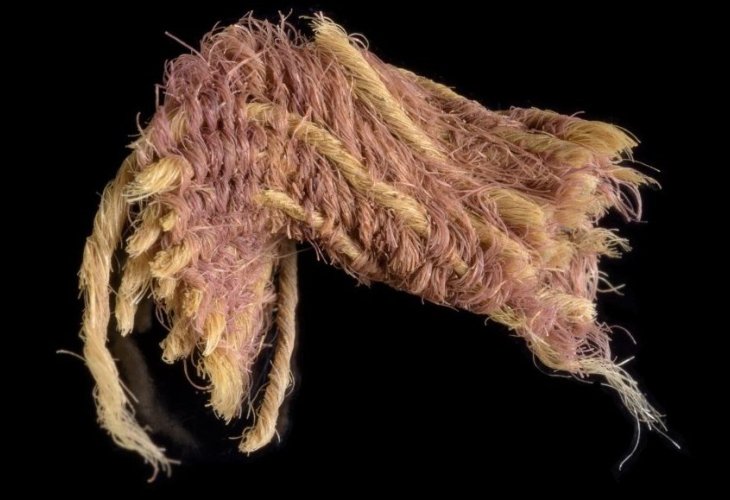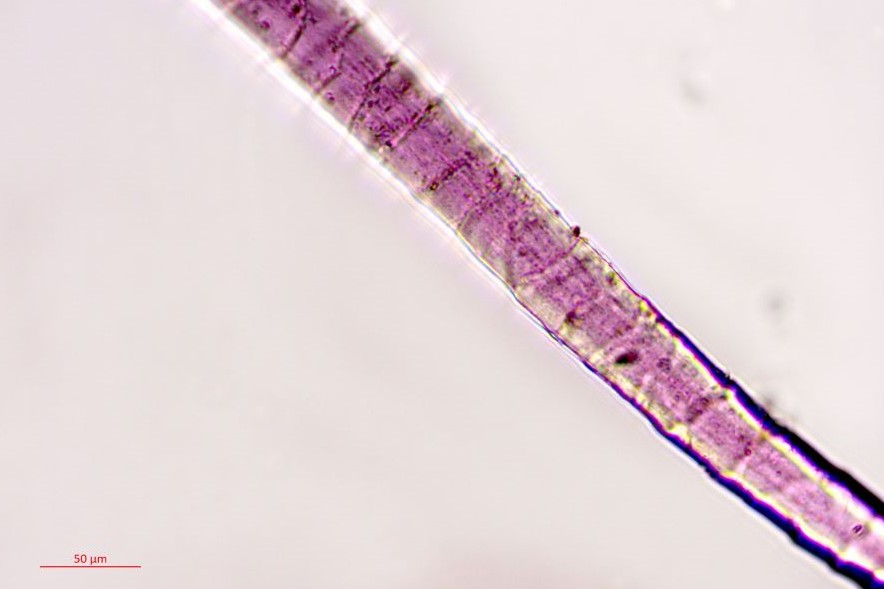Unveiling Ancient Royal Attire: How King David and Solomon Dressed 3,000 Years Ago
In an exciting breakthrough, archaeologists have unearthed pieces of fabric dyed with royal purple from the era of Kings David and Solomon in the Timna Valley. "The color immediately caught our eyes, but we couldn't believe we found true purple from such an ancient period," said researchers.
 A piece of rare fabric dyed purple (Photo: Dafna Gazit, Israel Antiquities Authority)
A piece of rare fabric dyed purple (Photo: Dafna Gazit, Israel Antiquities Authority)Historic Discovery: For the first time in Israel, archaeologists have found rare evidence of fabric dyed with royal purple from the time of Kings David and Solomon.
The unique fabric was discovered as part of ongoing research into dyed textiles from the Timna Valley region in the southern Arava. To the researchers' surprise, remnants of fabric, threads, and wool fibers were found dyed in the royal purple. The findings were scientifically dated to the period of David and Solomon in Jerusalem, around 1000 BCE.
The dye, extracted from species of Mediterranean mollusks located over 300 kilometers from Timna, is frequently mentioned in the Bible. This is the first time fabric dyed with purple from this period has been found in Israel and the southern Levant.
The research was led by Dr. Naama Sukenik from the Israel Antiquities Authority and Professor Erez Ben-Yosef from the Institute of Archaeology at Tel Aviv University, in collaboration with Professor Zohar Amar, Dr. David Iluz, and Dr. Alexander Varevak from Bar-Ilan University, and Dr. Orit Shamir from the Israel Antiquities Authority. The surprising findings were published today (Thursday) in the prestigious journal PLOS ONE.
"This is a very exciting and important discovery," explains Dr. Sukenik, curator of organic findings at the Israel Antiquities Authority. "This is the first time that a piece of fabric from the time of David and Solomon has been found, dyed in the prestigious purple. In ancient times, purple clothing was attributed to nobility, priests, and of course, kings. The beautiful color of purple, its resistance to fading, and the difficulty of extracting the dye found in the mollusk's body in tiny quantities have made it the most expensive dye, often priced higher than gold. Until this discovery, we only knew of mollusk waste and ceramic shards with paint stains, evidence of the purple industry during the Iron Age, but this is the first time we have direct evidence of the dyed textiles themselves, preserved for about 3,000 years."
 A piece of rare fabric dyed purple (Photo: Dafna Gazit, Israel Antiquities Authority)
A piece of rare fabric dyed purple (Photo: Dafna Gazit, Israel Antiquities Authority)Professor Erez Ben-Yosef from the Institute of Archaeology at Tel Aviv University added, "A Tel Aviv University delegation has been excavating at Timna continuously since 2013. Thanks to the extreme dryness of the place, we can also find organic materials such as textiles, ropes, and leathers from the Iron Age, the days of David and Solomon - a collection that gives us a unique glimpse into life during the biblical period. Even if we dig another hundred years in Jerusalem, we won't find fabrics from 3,000 years ago. The preservation at Timna is exceptional, and it only rivals much later sites like Masada and the Bar Kokhba caves."
"In recent years, we have been excavating a new site within Timna called 'Slave Hill.' The name might be misleading, as the workers there were not slaves at all but specialist craftsmen. Timna was a center of copper production, the oil of the Iron Age. Producing copper required advanced metallurgical knowledge, probably secret, and those who held this knowledge were the 'tech experts' of the time. 'Slave Hill' is the largest copper production site in the valley and is filled with stacks of industrial waste like slag from smelting furnaces. Among these piles, we found three colored pieces of fabric. The color immediately caught our eyes, but we couldn't believe we found real purple from such an early period."
 'Slave Hill' in the center of Timna Valley (Photo: Erez Ben Yosef and Timna Excavations Project by Tel Aviv University)
'Slave Hill' in the center of Timna Valley (Photo: Erez Ben Yosef and Timna Excavations Project by Tel Aviv University)The analytical tests conducted at Bar-Ilan University's laboratories, along with the dye reconstructions made by Professor Zohar Amar and Dr. Naama Sukenik, can indicate the species used for dyeing Timna's textiles and the shades they wanted to achieve. For the reconstruction of the purple dye with mollusks, Professor Amar traveled to Italy, where he cracked open thousands of mollusks and extracted a substance from their dye glands used for hundreds of attempts to replicate the ancient dyeing process. "The practical work took us back thousands of years," says Professor Amar. "It allowed us to better understand obscure historical sources related to the prestigious blue and purple dyes."
The color identification was done using a sophisticated analytical device (HPLC), which indicated the presence of unique dye molecules originating only from those mollusk species. According to Dr. Sukenik, "Most of the dyed textiles found at Timna, and in archaeological research in general, were dyed using various plants, which were available and easier to use for dyeing. Using animal-based dyes was considered much more prestigious and served as an important parameter that indicated the economic and social status of the wearer. The remnants of purple-dyed fabrics found are the oldest not only in Israel but in the entire southern Levant. Additionally, we believe we have identified on one of the pieces the double-dyeing method, advanced use of two types of mollusks to enrich the color. This technology is described by the Roman historian Pliny the Elder in the first century CE, and the dye produced was considered the most luxurious."
 Purple dyed wool fiber from Timna under a microscope (Photo: Dr. Naama Sukenik, Israel Antiquities Authority)
Purple dyed wool fiber from Timna under a microscope (Photo: Dr. Naama Sukenik, Israel Antiquities Authority)Professor Ben-Yosef identifies the copper production site at Timna with the biblical Kingdom of Edom, which bordered the Kingdom of Israel to the south. According to him, the dramatic findings should revolutionize the way we think about nomadic societies in the entire Iron Age: "The new findings strengthen our assumption that there was an elite class in Timna, meaning that the society there was stratified. Moreover, since the mollusks are sourced from the Mediterranean, this society must have had trade relations with other peoples living on the coastal plain. However, we do not consider the Kingdom of Edom to be a settlement-based kingdom. The Kingdom of Edom was a nomadic kingdom."
"When we think of nomads, it's hard not to equate them with contemporary Bedouins, and accordingly, it's hard to imagine kings without luxurious stone palaces and walled cities. But under certain conditions, nomads can also create complex socio-political structures. Of course, this entire discussion reflects back on Jerusalem. We know that the tribes of Israel were originally nomads and that the settlement process was long and slow. Archaeologists are searching for King David's palace, but perhaps David did not express his wealth through grand buildings but in a way more suited to a nomadic heritage, like in textiles and objects."
According to Ben-Yosef, "The new research at Timna has shown us that even without such buildings, there were rulers in our area who governed complex societies, formed alliances and trade connections, and fought one another. The expression of the wealth of a mobile society was not measured in palaces and stone monuments but in things that were no less precious in the ancient world - such as the copper produced at Timna and the purple traded with Timna's copper producers."

